根據香港法律,不得在業務過程中,向未成年人售賣或供應令人醺醉的酒類。
Under the law of Hong Kong, intoxicating liquor must not be sold or supplied to a minor in the course of business.
果味和芳香的味道, 光滑的酸度。
Fruity and aromatic in the taste, smooth note of acidity.
運送 Shipping
只送往香港本地
Hong Kong local delivery only
原産地 Country of Origin
徳國普法爾茨 Pfalz Germany
酒廠 Winery
魯佩茨具格霍夫斯多可庄園 Ruppertsberger Hofstück
規格 Specification
容量
Volume
750 毫升ml
顔色
Color
淺黃
Light yellow
酒精濃度
ABV
12.5%
類別
Type
白酒 White wine

魯佩茨具格烏查曼尼珍蔵白酒 2015
Ruppertsberger Gewürztraminer Kabinett 2015
帶有果味和芳香, 略帶酸性。
fruity and aromatic in the taste, slight acidic notes.
詳細資料 Wine Detail Information
酒精濃度
ALCOHOL
12.5 % Vol.
最佳飲用溫度
SERVING TEMPERTURE
6 - 10°C
食物搭配
FOOD PAIRING
甜品, 朱古力
Desserts, chocolate
葡萄品種
GRAPE VARIETY
徳國烏查曼尼
German Gewurztraminer
容量
VOLUME
750 ml
我們的葡萄酒
我們代表著“風土哲學”, 也就是說, 我們努力生産出反映葡萄園風土質量的葡萄酒。 例如, 我們可以在不同的泥土層上種植雷司令, 従而在葡萄酒中産生不同的香氣。 在此過程中, 我們特別熱衷於運用舊的經験和我們對酒窖中許多小面積葡萄園的知識。 我們将這些知識與全新, 創新和溫和的方法相結合, 使我們的葡萄酒口感更加新鮮,細膩和和諧。 因為這是我們追求的葡萄酒風格。
我們提供不同的葡萄酒系列, 每種葡萄酒都有不同的口味。 我們不僅在風土概念的幫助下生産這些葡萄, 而且還在熟成的各個階段收割葡萄。 如果我們在它們完全成熟後不久收割, 發酵後我們會得到特別清淡而果味濃郁的葡萄酒。 如果我們讓葡萄垂懸至晚期收割, 香氣就會改变, 变得更加多樣化和強大。 因此, 我們可以提供包括起泡葡萄酒到優質葡萄酒的各式各樣的葡萄酒。 因此, 通過我們的工藝, 我們不僅展示了Ruppertsberg葡萄酒村附近地區的多樣性和潛力, 還展示了我們在葡萄栽培方面的所有技能。
Our wines
We represent the "terroir philosophy", that is, we strive to produce wines that reflect the quality of the vineyards, the terroir. For example, we can develop a Riesling on different layers and thus create different aromas in the wine. In doing so, we are particularly keen to apply old experience and our knowledge of the many, no matter how small, vineyard parcels in our wine cellar. We combine this knowledge with completely new, innovative and gentle methods to make our wines taste even fresher, finer and more harmonious. Because this is the wine style that we pursue.
We carry different wine lines, each of which is supposed to serve very different tastes. We not only produce these with the help of the terroir concept, but we also harvest our grapes at various stages of ripeness. If we bring them in shortly after they are fully ripe, we get a particularly light and fruity wine after fermentation. If we let the grapes hang until the late harvest or selection stage, the aromas change and become more diverse and powerful. So we can offer everything from sparkling liter wine to fine premium wine. With our work, we therefore not only show the diversity and potential of our locations around the wine village of Ruppertsberg, but also all of our skills in viticulture.


歴史
創立
The Ruppertsberger Weinkeller Hoheburg是由葡萄酒種植者協會(成立於1911年)和Hoheburg合作社(成立於1917年)於1968年合併而成。 往後的進一步的合併以及Ruppertsberg的生產設施的擴展使我們的公司成為普法爾茨州(Palatinate)最現代化, 設備最齊全的公司之一。
命名
霍爾堡(Hoheburg)-我們的酒窖以一座中世紀城堡的名字命名, 這座城堡一直屹立於魯佩茨具堡(Ruppertsberg)直到14世紀, 並且可能是建立在羅馬堡壘的基礎上。 相信這裡有兩條羅馬馬路的交織。一條従萊茵河上的Altrip向著Kaiserslautern方向, 另一條則是従史特拉斯堡(Strasbourg)到Bingen。 在這個重要的十字路口附近製造了葡萄酒 - 羅馬士兵們的日常飲品。
魯佩茨具堡葡萄栽培
在這裡的葡萄園中發現的許多發現證明了我們近2000年的葡萄栽培歴史。 弗里德里希·馮·巴斯瑟曼·喬丹(Friedrich von Bassermann-Jordan)寫道四世紀的玻璃瓶:“一個玻璃瓶於1808年在魯佩茨具堡 附近的羅馬霍赫堡(Roman Hoheburg)的一個石棺中發現(...)顯然是一個葡萄酒倉庫。據說這些工人在現場喝酔了。” (資料来源:Friedrich von Bassermann-Jordan, Der Weinbau der Pfalz im Altertum, Neustadt 1946)。 這個地方和當地葡萄栽培的歴史可以追溯到很久以前。
History
Hounding
The Ruppertsberger Weinkeller Hoheburg was created through the merger of the winegrowers' association (founded in 1911) and the Hoheburg cooperative (founded in 1917) in 1968. Further mergers and the expansion of the production facility in Ruppertsberg made our company one of the most modern and best-equipped in the Palatinate.
Naming
Hoheburg - Our wine cellar is named after a medieval castle that stood on Ruppertsberg territory until the 14th century and was probably built on the foundations of a Roman fort. It is believed that two Roman roads crossed here. One led from Altrip on the Rhine in the direction of Kaiserslautern, the other from Strasbourg to Bingen. At this important intersection stood the aforementioned Roman fort, in the vicinity of which wine - an everyday drink for the Roman soldiers - was made.
Ruppertsberg viticulture
Numerous finds that were made in the vineyards here attest to the almost 2000-year history of our viticulture. Friedrich von Bassermann-Jordan writes about a glass barrel jug from the 4th century: “A glass bottle found in a stone coffin in 1808 in the formerly Roman Hoheburg near Ruppertsberg (...) clearly shows a wine depot. The workers are said to have drunk the contents at the site. " (Source: Friedrich von Bassermann-Jordan, The winegrowing of the Palatinate in antiquity, Neustadt 1946). The history of the place and the local viticulture goes back a long way.

葡萄園
在徳國葡萄酒之路陽光普照的葡萄酒小鎮魯佩茨具格(Ruppertsberg), 我們的86名葡萄種植者在400公頃的葡萄園上種植葡萄, 充滿了熱情, 經験和必要的敏感性。總體而言, 我們每年従約500公頃的葡萄園中銷售葡萄酒。
我們秉承這樣的理念, 即品質源於葡萄園, 並且在酒窖中变得更精緻。 我們的釀酒師非常了解他們的葡萄藤的每一個細微差別, 設法使各塊土地, 微氣候和天氣相協調, 展現出葡萄品種的特定特徵。 正是這種跨代的經験使我們的釀酒師能夠在每個年份生産出最好的葡萄, 従而将每個葡萄的品質帶入玻璃杯中。
當然, 顯然的氣候和非凡的土壤在這裡也起著重要作用。 Ruppertsberger Linsenbusch, Ruppertsberger Reiterpfad, Gimmendinger Meerspinne-這些是我們家園內外的一些葡萄園的名稱。 這些名稱有不同的来歴。它們通常基於歴史或以位置的特徵(例如土壤的形状或類型)而命名。有時, 它們也完全来自講述它們的故事的幻想。
Vineyards
In the sun-drenched wine town of Ruppertsberg on the German Wine Route, our 86 winegrowers grow their grapes on 400 hectares of vineyards with a lot of passion, experience and the necessary sensitivity. Overall, we market wines from a vineyard area of around 500 hectares per year.
We represent the philosophy that quality arises in the vineyard and is refined in the wine cellar. Our winemakers know every nuance of their rows of vines very well and thus manage to bring out the specific characteristics of the grape varieties in harmony with the soil, microclimate and weather of the respective parcel. It is precisely this cross-generational experience that enables our winemakers to produce the best grapes in each vintage and thus to bring the qualities of each vine into the glass.
Of course, the unmistakable climate and our extraordinary soils also play a major role here. Ruppertsberger Linsenbusch, Ruppertsberger Reiterpfad, Gimmeldinger Meerspinne - these are the names of some of our vineyards in and around our homeland. These names have different origins. They are often based on history or named after the characteristics of the location, such as the shape or the type of soil. Sometimes they also arise entirely from the fantasy of the stories that are told about them.


